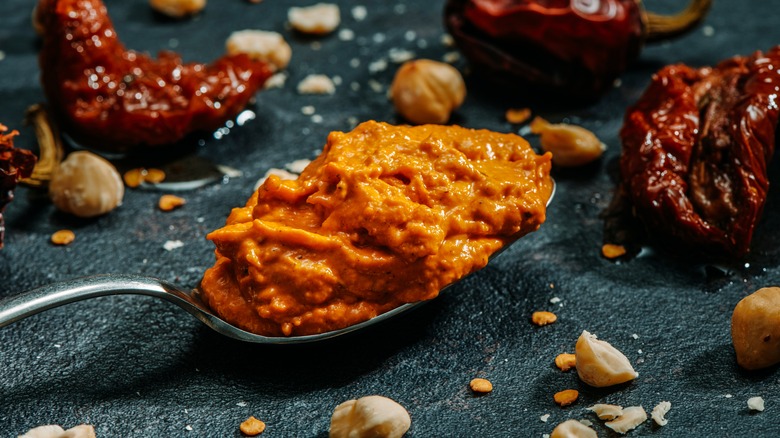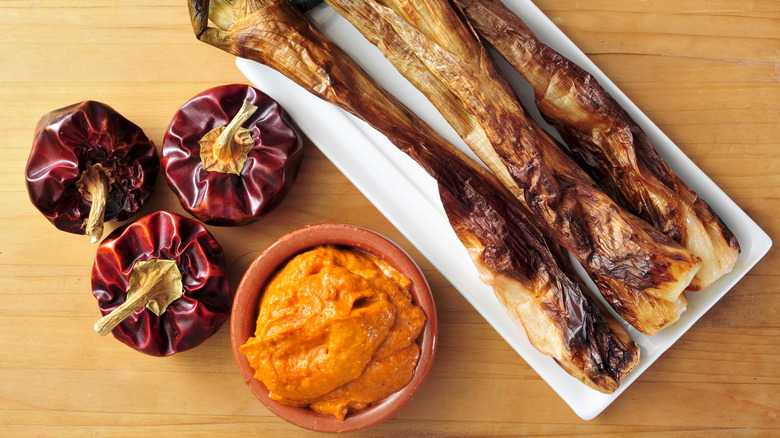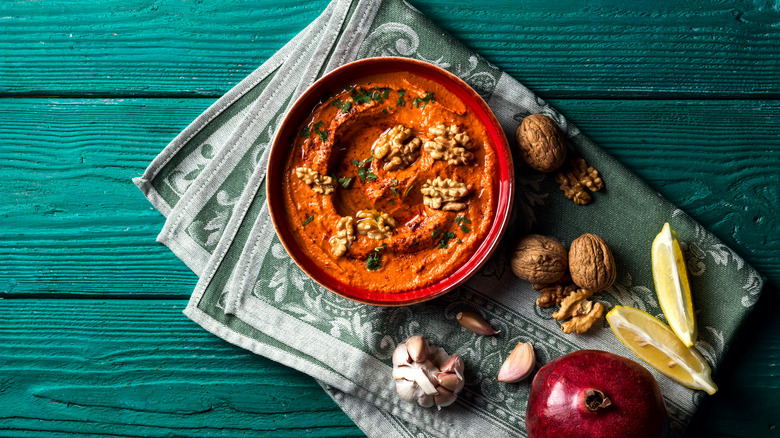Romesco Sauce Vs. Muhammara: What's The Difference?
It's been said that everyone has a doppelganger in the world, someone who has an uncanny resemblance to another person and no other relation. They can exist in the same city or in countries thousands of miles away from each other. The same can be said with certain foods. For example, frozen yogurt and soft serve ice cream look basically identical; however, their ingredients make them two totally different frozen treats. Italian-American calzones look like a bigger version of South American empanadas on the outside, but the fillings are far from the same. And looking at a bowl of muhammara and a dish of romesco sauce next to each other, you might swear the two are the same, but not so much.
Both are deep orange and almost red in appearance with a smooth but slightly chunky texture and can be used as dips for vegetables or bread or as accompaniments to meats and fish, per The Nibble. Each sauce would also be a welcome addition to any Mediterranean or Middle Eastern mezze platter. They each get their chunky appearance from ground nuts and bread. But, like any doppelganger (person or food), looks can be deceiving because romesco and muhammara are far from the same.
What is romesco sauce?
Cuisine with Me notes that Romesco sauce originated in the Catalonia region of Spain, the northeastern side of the country close to the French border. While the base ingredients of romesco sauce include red peppers, tomatoes, garlic, onion, bread, and spices, there are many variations. Famed Spanish chef José Andrés makes his version with all of the above ingredients plus ñora chili peppers, blanched almonds, and Sherry vinegar, per José Andrés. The bread acts as the thickening agent while the nuts give it texture, and the chilis used in romesco are typically not spicy.
The peppers, tomatoes, garlic, and onion are first oven-roasted, while the dried ñora peppers are soaked in hot water until soft and are then pureed. Meanwhile, the almonds and bread are toasted in a pan. The chili puree is then briefly heated in a saute pan. The roasted vegetables, almonds, bread, chili puree, vinegar, spices, and olive oil are then combined in a blender before being served as desired. Romesco is traditionally served in Spain as a dip for grilled calçots, sweet onions similar to scallions, per Saveur.
What is muhammara?
Aleppo, Syria, is over 2,600 walking miles from Catalonia, Spain, and it is the birthplace of muhammara sauce, according to Bon Appétit. The Guardian notes that, although you might not be able to tell the two apart, muhammara is spicier than its Spanish cousin. On his website, Yotam Ottolenghi, a chef and cookbook author who specializes in Middle Eastern cuisine, notes that Muhammara is made with red peppers, garlic, olive oil, and chili peppers but uses walnuts instead of almonds. In addition, there are no tomatoes, Aleppo peppers take the place of ñora peppers, and pomegranate molasses is a key ingredient.
Ottolenghi roasts red peppers in the oven until the skins are charred. He then covers the peppers in a bowl until the steam makes the skin easy to peel off. In a mortar and pestle, he combines the roasted peppers, breadcrumbs, lemon juice, pomegranate molasses, cumin, Aleppo peppers, and garlic. Walnuts, salt, olive oil, and sometimes more molasses are then added until your desired texture is achieved. The result is spicier and a bit sweeter than romesco sauce.


